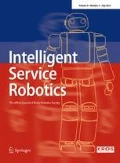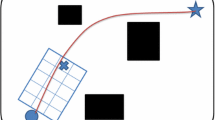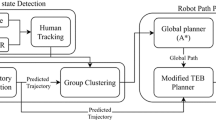Abstract
As mobile robots start operating in environments crowded with humans, human-aware navigation is required to make these robots navigate safely, efficiently and in socially compliant manner. People navigate in an interactive and cooperative fashion so that, they are able to find their path to a destination even if there is no clear route leading to it. There are significant efforts to solve this problem for mobile robots; however, they are not scalable to high human density and learning based approaches depend heavily on the context and configuration of the set they are trained with. We develop a method which infers initial trajectories from Gaussian processes and updates these trajectories jointly for all agents using a cost based interaction approach. We condition Gaussian processes online with the best hypothesis at each step of prediction horizon. The method is tested on a common public dataset and it is shown that it outperforms two state-of-the-art approaches in terms of human-likeness of predicted trajectories.












Similar content being viewed by others
References
Trautman P, Krause A (2010) Unfreezing the robot: navigation in dense, interacting crowds. In: 2010 IEEE/RSJ international conference on intelligent robots and systems, pp 797–803. https://doi.org/10.1109/IROS.2010.5654369
Bennewitz M (2005) Learning motion patterns of people for compliant robot motion. Int J Robot Res 24(1):31–48. https://doi.org/10.1177/0278364904048962
Helble H, Cameron S (2007) 3-D path planning and target trajectory prediction for the Oxford aerial tracking system. In: Proceedings—IEEE international conference on robotics and automation, pp 1042–1048. https://doi.org/10.1109/ROBOT.2007.363122
Thompson S, Horiuchi T, Kagami S (2009) A probabilistic model of human motion and navigation intent for mobile robot path planning. In: ICARA 2009—proceedings of the 4th international conference on autonomous robots and agents, pp 663–668. https://doi.org/10.1109/ICARA.2000.4803931
Helbing D, Molnár P (1995) Social force model for pedestrian dynamics. Phys Rev E 51(5):4282–4286. https://doi.org/10.1103/PhysRevE.51.4282
Helbing D, Farkas I, Vicsek T (2000) Simulating dynamical features of escape panic. Nature 407(July):487–490
Helbing D, Molnár P, Farkas IJ, Bolay K (2001) Self-organizing pedestrian movement. Environ Plan 28(3):361–383. https://doi.org/10.1068/b2697
Luber M, Stork JA, Tipaldi GD, Arras KO (2010) People tracking with human motion predictions from social forces. In: Proceedings—IEEE international conference on robotics and automation, pp 464–469. https://doi.org/10.1109/ROBOT.2010.5509779
Pellegrini S, Ess A, Schindler K, Gool LV (2009) You’ll never walk alone: modeling social behavior for multi-target tracking.pdf (Iccv), pp 261–268
Pellegrini S, Ess A, Tanaskovic M, Van Gool L (2010) Wrong turn—no dead end: a stochastic pedestrian motion model. In: 2010 IEEE computer society conference on computer vision and pattern recognition—workshops, CVPRW 2010, pp 15–22. https://doi.org/10.1109/CVPRW.2010.5543166
Helbing D, Johansson A (2011) Pedestrian, crowd and evacuation dynamics. Springer, New York, pp 697–716
Truong XT, Yoong VN, Ngo TD (2017) Socially aware robot navigation system in human interactive environments. Intel Serv Robot 10(4):287–295. https://doi.org/10.1007/s11370-017-0232-y
Fiorini P, Shiller Z (1998) Motion planning in dynamic environments using the relative velocity paradigm. Int J Robot Res 17(7):760–772. https://doi.org/10.1109/robot.1993.292038
Van Berg JD, Lin M, Manocha D (2008) Reciprocal velocity obstacles for real-time multi-agent navigation. In: Proceedings—IEEE international conference on robotics and automation, pp 1928–1935. https://doi.org/10.1109/ROBOT.2008.4543489
Khatib O (1986) Real-time obstacle avoidance for manipulators and mobile robots. Int J Robot Res 5(1):90–98. https://doi.org/10.1177/027836498600500106
Koren Y (1991) Potential field methods and their limitations for mobile robot navigation. In: Proceedings of IEEE international conference on robotics and automation, pp 1398–1404
Hall ET (1974) Handbook for proxemic research. In: Society for the anthropology of visual communication
Svenstrup M, Bak T, Andersen HJ (2010) Trajectory planning for robots in dynamic human environments. In: 2010 IEEE/RSJ international conference on intelligent robots and systems, pp 4293–4298. https://doi.org/10.1109/IROS.2010.5651531
Pradhan N, Burg T, Birchfield S (2011) Robot crowd navigation using predictive position fields in the potential function framework. In: Proceedings of the 2011 American control conference, pp 4628–4633. https://doi.org/10.1109/ACC.2011.5991384
Ziebart BD, Ratliff N, Gallagher G, Mertz C, Peterson K, Bagnell JA, Hebert M, Dey AK, Srinivasa S (2009) Planning-based prediction for pedestrians. In: 2009 IEEE/RSJ international conference on intelligent robots and systems, IROS 2009, May 2014, pp 3931–3936. https://doi.org/10.1109/IROS.2009.5354147
Trautman P, Ma J, Murray RM, Krause A (2013) Robot navigation in dense human crowds: the case for cooperation. In: 2013 IEEE international conference on robotics and automation, pp 2153–2160. https://doi.org/10.1109/ICRA.2013.6630866
Kuderer M, Kretzschmar H, Sprunk C, Burgard W (2012) Feature-based prediction of trajectories for socially compliant navigation. In: Robotics: science and systems
Kuderer M, Kretzschmar H, Burgard W (2013) Teaching mobile robots to cooperatively navigate in populated environments. In: 2013 IEEE/RSJ international conference on intelligent robots and systems, pp 3138–3143. https://doi.org/10.1109/IROS.2013.6696802
Kretzschmar H, Spies M, Sprunk C, Burgard W (2016) Socially compliant mobile robot navigation via inverse reinforcement learning. Int J Robot Res 35(11):1352–1370. https://doi.org/10.1177/0278364915619772
Kim B, Pineau J (2013) Human-like navigation: socially adaptive path planning in dynamic environments. In: RSS 2013 workshop on inverse optimal control and robotic learning from demonstration
Vasquez D, Okal B, Arras KO (2014) Inverse reinforcement learning algorithms and features for robot navigation in crowds: an experimental comparison. In: 2014 IEEE/RSJ international conference on intelligent robots and systems (Iros), pp 1341–1346. https://doi.org/10.1109/IROS.2014.6942731
Turnwald A, Althoff D, Wollherr D, Buss M (2016) Understanding human avoidance behavior: interaction-aware decision making based on game theory. Int J Soc Robot 8(2):331–351. https://doi.org/10.1007/s12369-016-0342-2
Turnwald A, Wollherr D (2018) Human-like motion planning based on game theoretic decision making. Int J Soc Robot. https://doi.org/10.1007/s12369-018-0487-2
Vemula A, Muelling K, Oh J (2017) Modeling cooperative navigation in dense human crowds. In: Proceedings—IEEE international conference on robotics and automation, pp 1685–1692. https://doi.org/10.1109/ICRA.2017.7989199, arxiv:1705.06201
Alahi A, Goel K, Ramanathan V, Robicquet A, Fei-Fei L, Savarese S (2016) Social LSTM: human trajectory prediction in crowded spaces. In: 2016 IEEE conference on computer vision and pattern recognition (CVPR), pp 961–971. https://doi.org/10.1109/CVPR.2016.110
Alahi A, Ramanathan V, Fei-Fei L (2017) Tracking millions of humans in crowded spaces. In: Group and crowd behavior for computer vision (i), pp 115–135. https://doi.org/10.1016/B978-0-12-809276-7.00007-2
Bartoli F, Lisanti G, Ballan L, Del Bimbo A (2018) Context-aware trajectory prediction. ICPR, pp 1941–1946
Bhattacharyya A, Fritz M, Schiele B (2018) Long-term on-board prediction of people in traffic scenes under uncertainty. CVPR
Chandra R, Bhattacharya U, Bera A, Manocha D (2019) Traphic: trajectory prediction in dense and heterogeneous traffic using weighted interactions. CVPR
Xue H, Huynh DQ, Reynolds M (2018) SS-LSTM: a hierarchical LSTM model for pedestrian trajectory prediction. CVPR, pp 1186–1194
Trautman P (2018) Sparse interacting Gaussian processes: efficiency and optimality theorems of autonomous crowd navigation. In: 2017 IEEE 56th annual conference on decision and control, CDC 2017 2018-January(May), pp 327–334. https://doi.org/10.1109/CDC.2017.8263686, arXiv:1705.03639v1
Trautman P, Ma J, Murray RM, Krause A (2015) Robot navigation in dense human crowds: statistical models and experimental studies of human-robot cooperation. Int J Robot Res 34(3):335–356. https://doi.org/10.1177/0278364914557874, arxiv:1504.00702
Epley N, Waytz A, Cacioppo JT (2007) On seeing human: a three-factor theory of anthropomorphism. Psychol Rev 114(4):864–86. https://doi.org/10.1037/0033-295X.114.4.864
Papadopoulos AV, Bascetta L, Ferretti G (2016) Generation of human walking paths. Auton Robot 40(1):59–75. https://doi.org/10.1007/s10514-015-9443-2
LaValle SM (2006) Planning algorithms. Plan Algorithms 9780521862059:1–826. https://doi.org/10.1017/CBO9780511546877
Ellis D, Sommerlade E, Reid I (2009) Modelling pedestrian trajectories with gaussian processes. Ninth Int Workshop Vis Surveill 1:27110–27110. https://doi.org/10.1109/ICCVW.2009.5457470
Kim K, Lee D, Essa I (2012) Detecting regions of interest in dynamic scenes with camera motions. In: Proceedings of the IEEE computer society conference on computer vision and pattern recognition, pp 1258–1265. https://doi.org/10.1109/CVPR.2012.6247809
Marder-Eppstein E, Berger E, Foote T, Gerkey B, Konolige K (2010) The office marathon: robust navigation in an indoor office environment. In: International conference on robotics and automation
Ashton NL, Shaw ME (1980) Empirical investigations of a reconceptualized personal space. Bull Psychon Soc 15(5):309–312. https://doi.org/10.3758/BF03334542
Aiello JR (1987) Human spatial behavior. Handbook of environmental psychology. Wiley, New York, pp 359–504
Gérin-Lajoie M, Richards CL, McFadyen BJ (2005) The negotiation of stationary and moving obstructions during walking: anticipatory locomotor adaptations and preservation of personal space. Mot Control 9(3):242–69. https://doi.org/10.1123/mcj.9.3.242
Kirby R, Simmons R, Forlizzi J (2009) Companion: a constraint-optimizing method for person-acceptable navigation. In: RO-MAN 2009—the 18th IEEE international symposium on robot and human interactive communication, pp 607–612. https://doi.org/10.1109/ROMAN.2009.5326271
Nakauchi Y, Simmons RG (2002) A social robot that stands in line. Auton Robots 12:313–324
Walters ML, Dautenhahn K, te Boekhorst R, , Kaouri C, Woods S, Nehaniv C, Lee D, Werry I (2005) The influence of subjects’ personality traits on personal spatial zones in a human-robot interaction experiment. In: ROMAN 2005. IEEE international workshop on robot and human interactive communication, pp 347–352. https://doi.org/10.1109/ROMAN.2005.1513803
Hall ET (1966) The hidden dimension. Doubleday, New York
Wall-Scheffler CM (2012) Size and shape: morphology’s impact on human speed and mobility. J Anthropol 2012:1–9. https://doi.org/10.1155/2012/340493
Wagnild J, Wall-Scheffler CM (2013) Energetic consequences of human sociality: walking speed choices among friendly dyads. PLoS ONE 8(10):1–6. https://doi.org/10.1371/journal.pone.0076576
Alexander RMN (2002) Energetics and optimization of human walking and running: the 2000 Raymond Pearl memorial lecture. Am J Hum Biol 14(5):641–648. https://doi.org/10.1002/ajhb.10067
O’Connor SM, Donelan JM (2012) Fast visual prediction and slow optimization of preferred walking speed. J Neurophysiol 107(9):2549–2559. https://doi.org/10.1152/jn.00866.2011
Bastien GJ, Willems PA, Schepens B, Heglund NC (2005) Effect of load and speed on the energetic cost of human walking. Eur J Appl Physiol 94(1–2):76–83. https://doi.org/10.1007/s00421-004-1286-z
DeJaeger D, Willems PA, Heglund NC (2001) The energy cost of walking in children. Pflugers Arch 441(4):538–543. https://doi.org/10.1007/s004240000443
Browning RC, Kram R (2005) Energetic cost and preferred speed of walking in obese vs. normal weight women. Obes Res 13(5):891–899. https://doi.org/10.1038/oby.2005.103
Browning RC, Baker EA, Herron JA, Kram R (2006) Effects of obesity and sex on the energetic cost and preferred speed of walking. J Appl Physiol 100(2):390–398. https://doi.org/10.1152/japplphysiol.00767.2005
Colman AM (2003) Cooperation, psychological game theory, and limitations of rationality in social interaction. Behav Brain Sci 26(2):139–153. https://doi.org/10.1017/S0140525X03470052
Bitgood S, Dukes S (2006) Not another step! Economy of movement and pedestrian choice point behavior in shopping malls. Environ Behav 38(3):394–405. https://doi.org/10.1177/0013916505280081
Csibra G, Gergely G, Biro S, Koos O, Brockbank M (1999) Goal attribution without agency cues: the perception of ’pure reason’ in infancy. Cognition 72(3):237–267
Author information
Authors and Affiliations
Corresponding author
Additional information
Publisher's Note
Springer Nature remains neutral with regard to jurisdictional claims in published maps and institutional affiliations.
Rights and permissions
About this article
Cite this article
Hacinecipoglu, A., Konukseven, E.I. & Koku, A.B. Multiple human trajectory prediction and cooperative navigation modeling in crowded scenes. Intel Serv Robotics 13, 479–493 (2020). https://doi.org/10.1007/s11370-020-00333-8
Received:
Accepted:
Published:
Issue Date:
DOI: https://doi.org/10.1007/s11370-020-00333-8




